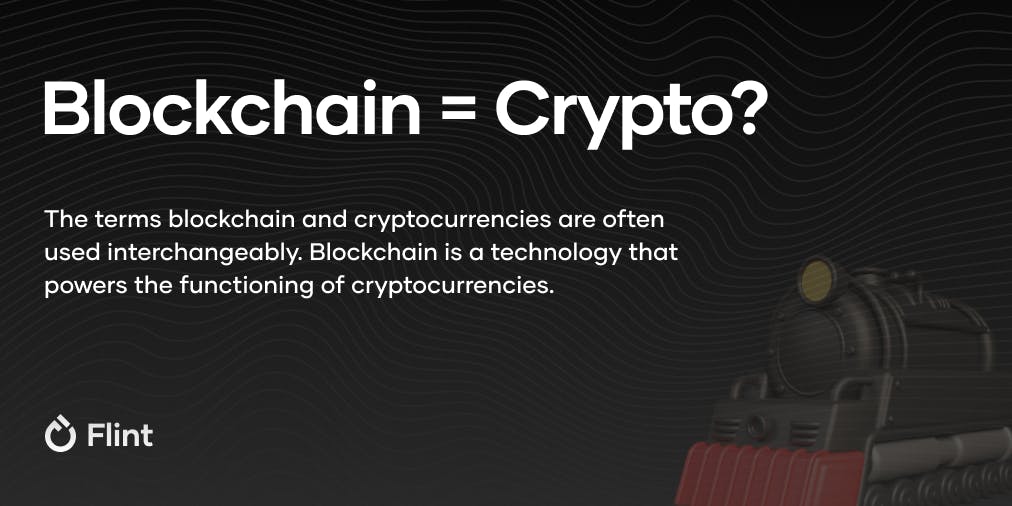Difference Between Blockchain and Crypto
Jump to:

What is blockchain?
According to IBM,
Blockchain is a shared, immutable ledger that facilitates the process of recording transactions and tracking assets in a business network. An asset can be tangible (a house, car, cash, land) or intangible (intellectual property, patents, copyrights, branding). Virtually anything of value can be tracked and traded on a blockchain network, reducing risk and cutting costs for all involved.
This may sound intimidating, but don’t worry. By the end of this blog, you’ll be able to have a clear understanding of what blockchains are.
Let’s learn this with the help of trains 🚂
Imagine a train where each bogey contains passengers on seats. The train is present at every station. As the passengers keep increasing, new bogeys need to be added. But, how will the bogeys be added?
The supervisor checks if each seat is occupied before adding a new bogey. The supervisor also connects the subsequent bogey with the previous one.
But there’s a catch, before the addition of bogey, other supervisors also check if the seats in bogey are fine. And If they are, the bogey is added to the train standing at each station. The supervisor gets rewarded for the time and energy he spent.
How is this related to blockchains? In this case:
Train: Blockchain
Bogey: Block
Seats: Transactions
Stations: Computers/nodes
Supervisors: Miners
Connecting the bogey: Calculating the hash
Blockchain is a chain of blocks like a train is a chain of bogeys. Blocks contain transactions just like bogeys contain seats. Just like the train is present on every station, the blockchain is present on every station. To add a new block to the chain, you need to calculate a hash. This is similar to connecting the two bogeys by the supervisor. Here, the supervisor is the miner in blockchain technology. Miners get rewarded in the cryptocurrency for adding every block to the chain.
Since there are rewards, everyone would be eager to add a new block to the chain. But, how is it decided which supervisor should get the opportunity to do the work?
If you haven’t already, read our article about What is Blockchain?
Consensus mechanisms come to the rescue
Although there are many consensus mechanisms, these two are most popular.
- Proof of Work (PoW)
- Proof of Stake (PoS)
To understand What is Proof of Work? or What is Proof of Stake? refer the linked articles
In Proof of Work, the supervisors (miners) check if each seat is occupied at every station. The one who checks first will be rewarded while others lose their time and energy.
In Proof of Stake, Supervisors (miners) stake their coins to win a lucky draw. The winner supervisor (miner) will own the right to check seats of new bogey (block) and get rewarded for it.
Proof of stake uses significantly less energy than proof of work. Currently, Bitcoin uses PoW, and Ethereum is transitioning from PoW to PoS
If you haven’t already, read about Ethereum’s shift from proof of work to proof of stake and the much-anticipated event 'The Merge'
Cryptocurrency
It is digital money with market value like every other currency.
Like other currencies run with the help of central banks and the government, blockchain technology is used to transfer, store, and keep track of cryptocurrencies. The transactions mentioned above, inside blocks, are all in cryptocurrency.
Cryptocurrencies have a monetary value, but blockchains don’t have any monetary value. Cryptocurrency gets listed on exchanges like Binance, Coinbase, KuCoin, etc for a specific price, but blockchains don’t get listed on any exchange.
Blockchains are decentralized and highly transparent, meaning that it is stored everywhere (on every station), and anybody can access them. Cryptocurrencies are accessed only via crypto wallets and offer anonymity.
Beyond cryptocurrencies?
Blockchain has applications beyond cryptocurrencies.
There are lots of innovative ways in which blockchains can be used.
Banking: DeFi (read our article on What is DeFi? )
Health: Patents’ encrypted health information
Voting: Fast and verifiable votes using smartphones
Identification: Digital IDs.
According to a report by Gartner, the business value added by blockchain will grow to more than $176B by 2025. By 2030, it will exceed $3.1T showing exponential growth in a few years.
Like this article? Spread the word
Subscribe to our
newsletter!
Receive timely updates on new posts & articles about crypto world.